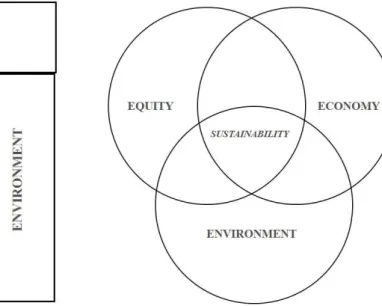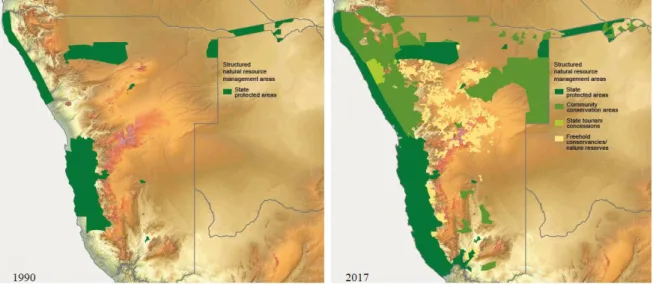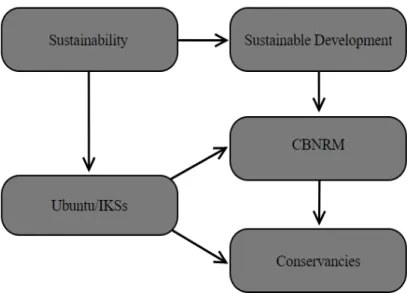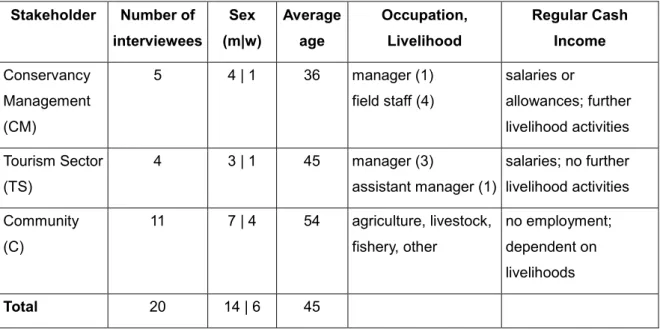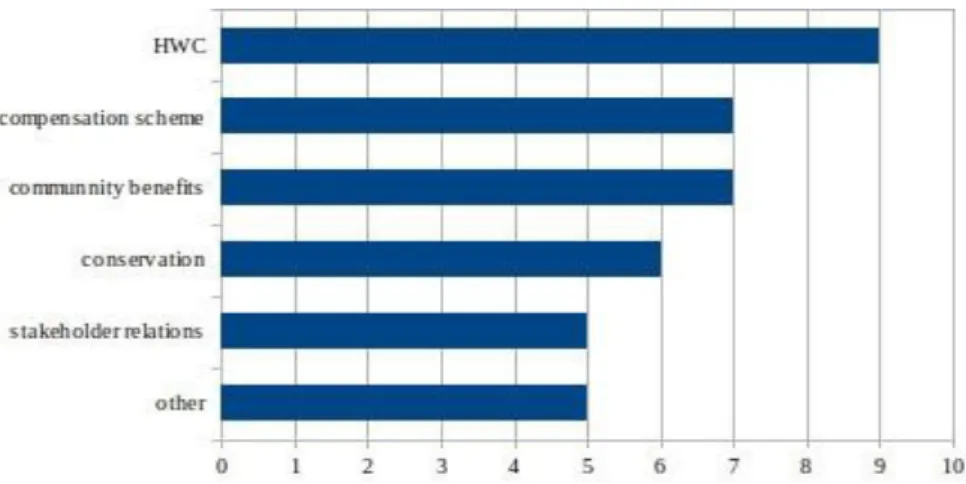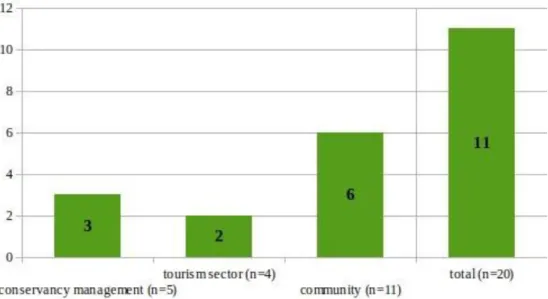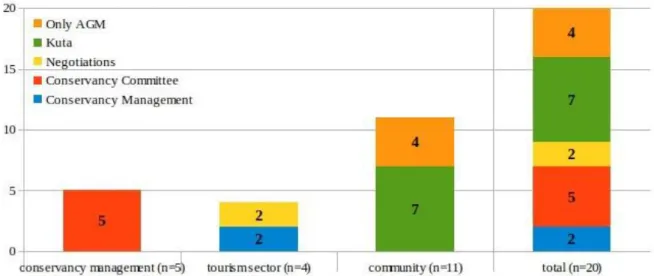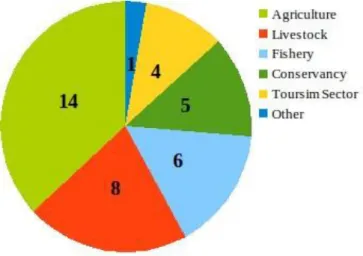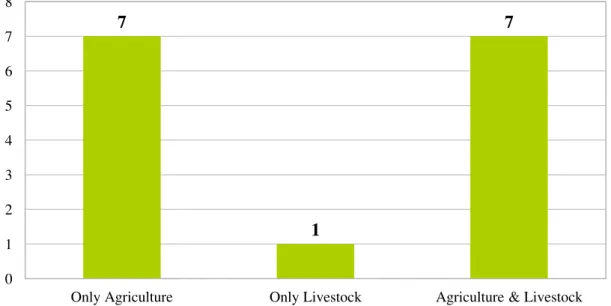David Greven
Conservancies and their Impact on Livelihood and Environment: The Example of Impalila Conservancy
Edited by the Cologne African Studies Centre
Cologne 2018
15
David Greven
Conservancies and their Impact on Livelihood and Environment The Example of Impalila Conservancy
CULTURE AND ENVIRONMENT IN AFRICA SERIES
Edited by the Cologne Africa Studies Centre
Issue 15 2018
This publication was funded by the Collaborative Research Center “Future Rural Africa”
(CRC/Transregio 228, funded by DFG).
Preface
In den vergangenen zwanzig Jahren hat sich die Ethnologie verstärkt mit den Konsequenzen und Praktiken des Umweltschutzes und Artenschutzes im Globalen Süden, insbesondere in Afrika, auseinandersetzt. Nach dem Weltgipfel von Rio 1992 haben sich Maßnahmen des Umweltschutzes deutlich gestärkt. Neben einer Erweiterung von Nationalparks und anderen Schutzgebieten, in denen menschliche Nutzung ausgeschlossen wird, nahmen besonders Gebiete zu, die entweder in gemeinschaftsbasierten Ansätzen oder auf privater Basis neue Formen des Naturschutzes implementierten. Namibia ist in dieser Hinsicht ein paradigmatischer Fall. Mittlerweile sind dort knapp 50 Prozent der Staatsfläche in Schutzmaßnahmen einbezogen. Insbesondere gemeinschaftsbasierte Ansätze haben in den vergangenen 20 Jahren rasch an Raum gewonnen. 1996 schuf die namibische Regierung ein neues Rechtsstatut, das hier in vielerlei Hinsicht eine neue Basis schuf. Das zuständige Ministerium konzedierte, dass unter bestimmten Bedingungen, Wild durch lokale Gemeinschaften genutzt werden könne.
Dafür mussten folgende Maßnahmen ergriffen werden. Eine Gemeinschaft musste ein
„Managementgebiet“ mit klaren Grenzziehungen definieren und die soziale Gruppe klar umreißen (eingetragene, formalisierte Mitgliedschaft), die dieses Gebiet bewirtschaftet.
Zusätzlich musste eine Managementplan erstellt werden, der deutlich machte, wie Wild in den Grenzen dieser Conservancy, so der namibische terminus technicus, bewirtschaftet werden solle. Dazu mussten interne Schutzzonen ausgewiesen werden, sogenannte Core Conservation Areas. Das verbleibende Gebiet der Conservancy wurde in verschiedene Nutzungszonen geteilt. Meist wurde eine weitere Zone für touristische Zwecke ausgewiesen. Nachdem der Managementplan durch das zuständige Ministerium abgenommen und die Conservancy offiziell ausgewiesen war, wurden durch das Ministerium jährliche Wildtierquoten zur eigenen Nutzung angegeben. Diese konnten dann prinzipiell selber abgejagt werden, oder an kommerzielle Jagdunternehmer gewinnbringend weiterverkauft werden. In Namibia wurde vornehmlich letztere Möglichkeit genutzt. Die Jagdunternehmer verkauften die Quoten dann per Tier weiter an touristische Trophäenjäger.
Die Einkommen aus der kommerzialisierten Jagd sind insbesondere in den letzten zehn Jahren deutlich gestiegen. Zusätzlich zum Recht der kontrollierten Wildtiernutzung erwarb eine Conservancy das Recht, Flächen an Privatunternehmer, hier meist Tourismusunternehmer, zu verpachten. Auf den verpachteten Flächen konnten dann Hotels oder mitunter auch Campingplätze entstehen. In Verträgen wurde festgelegt, dass Teile der Belegschaft lokal rekrutiert werden mussten.
Abstract
This present study examines the impact of conservancies on community livelihoods and the environment by the example of Impalila Conservancy, a conservancy located in the most north-eastern part of Namibia. The data is based on a literature research, informal interviews, unstructured interviews and 20 semi-structured interviews with representatives of the different stakeholder groups, i.e. the conservancy management, the tourism sector and the community, to assess respective problems and perception of stakeholders within the conservancy setting. First, a survey is given on the theoretical framework of the conservancy approach that is based on the concepts of sustainability, ubuntu/ indigenous knowledge systems and community-based natural resource management. The data revealed that Impalila Conservancy currently does not belong to the successful Namibian conservancies. Deficits, some with different priorities depending on the stakeholder group, were identified at different levels, such as (1) institutional development and governance, (2) natural resource management and conservation, (3) economic conservation approaches and livelihood diversification, and (4) stakeholder relations. These deficits were largely attributed to previous mismanagements.
Key Words: Natural Resource Management, Community-Based Natural Resource Management, Institutional Development, Conservation, Human-Wildlife Conflicts.
Acknowledgements
First, I would like to thank my supervisor Prof. Dr. Widlok at the University of Cologne for the support and the introduction into the very interesting topic of CBNRM that will certainly accompany me in the future. The initial support in Namibia and the week with the Collaborative Research Centre was very instructive.
I would also like to thank Prof. Dr. Klingelhoeffer at the University of Namibia in Katima Mulilo for his enthusiasm about my research, and his introduction and support in the study area.
A special thank you to David, my guide on Impalila Island, with whom I walked numerous kilometres over the island to conduct my interviews.
Finally, I express my gratitude to my family and to my girlfriend for providing me support and encouragement throughout my studies.
Thank you.
David Greven
Table of Contents
1. Introduction ... 1
2. Sustainability ... 4
2.1 Communal and Economical Sustainability ... 5
2.2 Ecological and Environmental Sustainability ... 6
2.3 Sustainable Development ... 7
3. Ubuntu ... 9
3.1 Implementation of Ubuntu ... 11
3.2 Ubuntu and the Environment ...12
4. Natural Resources Management ...16
4.1 Community-Based Natural Resource Management ...16
4.2 Conceptual Framework of Community-Based Natural Resource Management ...18
5. Community-Based Resource Management in Namibia ...21
5.1 Conservation in Pre-Independence Namibia ...21
5.2 Policies towards Community-Based Natural Resource Management in Namibia ....23
5.3 Conservancies...24
6. Interim Conclusion ...29
7. Case Study – Impalila Conservancy ...32
7.1 Study Area ...32
7.2 Methodology ...34
7.3 Research Sample ...37
7.4 Limitation in the Field...38
8. Results ...39
8.1 Institutional Development and Governance ...40
8.1.1 Problems of Impalila Conservancy ...40
8.1.2 Awareness of Processes in the Conservancy ...41
8.1.3 Work Circumstances in the Conservancy ...42
8.1.4 Future Prospects...43
8.2 Natural Resource Management and Conservation ...43
8.2.1 Benefits for the Environment ...43
8.2.2 Natural Resource Management ...43
8.2.3 Future Prospects...44
8.3 Economic Conservation Approaches and Livelihood Diversification ...45
8.3.1 Benefits for Community Livelihood ...45
8.3.2 Employment ...45
8.3.3 Community Livelihoods ...45
8.3.4 Human-Wildlife Conflicts ...47
8.3.5 Future Prospects...47
8.4 Stakeholder Relations ...48
8.4.1 Perception on Conservancies ...48
8.4.2 Perception on Tourism Sector ...50
8.4.3 Stakeholder Cooperation ...50
8.5 Integrated Rural Development and Nature Conservation (IRDNC) ...51
9. Discussion...53
9.1 Institutional Development and Governance ...53
9.2 Natural Resource Management and Conservation ...58
9.3 Economic Conservation Approaches and Livelihood Diversification ...63
9.4 Stakeholder Relations ...68
10. Conclusion ...73
References ...76
Appendices ...82
Appendix I: Core-Questionnaire ...82
Appendix II: Further Questions ...84
Appendix III: List of interviewees and interviews ...86
List of Abbreviations
AGM – Annual General Meeting
CAMPFIRE – Communal Areas Management Programme For Indigenous Resources CBNRM – Community-Based Natural Resource Management
CGG – Community Game Guard
DBAD – Department of Bantu Administration and Development HWC – Human-Wildlife Conflict
IKS – Indigenous Knowledge System
IRDNC – Integrated Rural Development and Nature Conservation LIFE – Living In a Finite Environment
MET – Ministry of Environment and Tourism
MCED – Ministerial Conference on Environment and Development MWCT – Ministry of Wildlife Conservation and Tourism
NACSO – Namibian Association of CBNRM Support Organisation NGO – Non-Governmental Organisation
NNF – Namibian Nature Foundation NRM – Natural Resource Management NTB – Namibian Tourism Board
NWT – Namibian Wildlife Trust
OECD – Organisation of Economic Cooperation and Development SADF – South African Defence Force
SWAA – South West African Administration TRC – Truth and Reconciliation Commission
UNCED – United Nations Conference on Environment and Development UNEP – United Nations Environment Programme
WCED – World Commission on Environment and Development WTO – World Trade Organisation
WWF – World Wildlife Fund
List of Figures
Figure 1 The three pillars of sustainability ... 5
Figure 2 The three co-equal parts relevant for achieving or failing sustainability ... 5
Figure 3 Total returns of conservancies and members ...27
Figure 4 Connecting the theoretical frameworks ...30
Figure 5 Total mentions of important topics in Impalila Conservancy. ...40
Figure 6 Mentions of HWC as problem in Impalila Conservancy. ...41
Figure 7 Source of information about conservancy matters ...42
Figure 8 “Are the efforts of Impalila Conservancy sustainable for the environment?” ...44
Figure 9 Livelihood Distribution. ...46
Figure 10 Livelihood Distribution in the Community. ...46
Figure 11 Mixed Livelihood in the Community ...46
Figure 12 Distribution of livelihood activities (n=15) relevant for HWCs ...47
Figure 13 “Are the efforts of Impalila Conservancy sustainable for the community?” ...48
Figure 14 “Do you agree with the implementation of the conservancy concept in Namibia?” ... 49
Figure 15 “Do you agree with the implementation of the conservancy concept in Impalila?” ... 49
Figure 16 “Do you agree with the actions of the tourism sector on Impalila?” ...50
Figure 17 Newly constructed fences on Impalila Island ...61
List of Maps Map 1 The expansion of conservancies in Namibia ...27
Map 2 Impalila Island and neighbouring countries ...32
Map 3 Zonation of Impalila Conservancy ...34
List of Tables Table 1 Characteristics of the interviewed stakeholders ...37
1. Introduction
Mankind is faced with a variety of global environmental problems such as – to name just a few - climate change, pollution of the sea, the protection of forests, the preservation of endangered plants and animal species, population growth, depletion of natural resources and increasing conflicts over the access of resources (WWF 2017a: 1). While these problems are of global scope and should be tackled at a regional level, especially countries of the global south have been often affected by insufficient natural resource management.
But there is no universal way to properly manage these resources. With regard to natural resources and environment, there exist several concepts for sustainable utilization, such as the sustainable development approach. Developments of the last years have shown, however, that approaches solely based on Western concepts have often proved to be insufficient for many non-western countries or to further worsen the situation. Especially, a centralized control over natural resources executed by governments appeared to be unsuitable (Schiffer 2004: 26f). Therefore, the concept of community-based resource management (CBNRM) has gained enormous prominence in the recent years, especially in Africa (Long & Jones 2004: 25). However, this concept is not entirely new, but has been practised by rural communities for centuries through traditional authorities, religious beliefs and cultural rules. In Namibia and many other African countries, CBNRM was later weakened by the colonial rule, the centralization of authority, the marginalisation of traditional authorities, population growth, and war. Modern CBNRM approaches are now used as tools for rural development and nature conservation attempting to recreate former conditions and to introduce new ideas, under which communities may successfully manage their resources (Jones & Erdmann 2013: 13).
Since 1996, conservancies have been implemented all over Namibia as the country's unique concept of CBNRM. A conservancy
"consists of a group of commercial farms or areas of communal land on which neighbouring land owners or members have pooled their resources for the purpose of conserving and using wildlife sustainably” (Ministry of Education of Namibia 1997: 1).
The conservancy concept has received considerable legislative support from the government that has adjusted several constitutional acts in favour of conservancies.
Furthermore, Namibian non-governmental organisations (NGOs)1 , and the Ministry of Environment and Tourism (MET) are continuously promoting conservancies through publications of brochures, booklets and data accessible online. Representatives of the
1 Such as the Namibian Association of CBNRM Supporting Organisations (NACSO), Integrated Rural Development and Nature Conservation (IRDNC), Namibian Nature Foundation (NNF), etc.
tourism sector, such as the Namibian Tourism Board (NTB), offer a variety of information specifically to tourist to promote concepts of sustainability and conservancies (NTB 2009).
Investors, like the Nedbank Namibia, are publishing or financing brochures also promoting sustainability and CBNRM, and even board magazines on domestic flights spread the success story of Namibia's conservancies (NamParks 2017). On the whole, Namibia's conservancies seem to be quite successful. Today, 83 conservancies cover almost 20% of the whole country and generate considerable revenues for its communities (NACSO 2016:
7). This does not mean, however, that there are no problems, e.g. caused by human-wildlife- conflicts (HWCs), as conservancies vary widely regarding income potential, physical features and community acceptance (Harring & Odendaal 2012: 18f).
This present thesis is a case study carried out in Impalila Conservancy, a small conservancy situated in the far north-east of the Zambezi region. Results are mainly based on semi- structured and unstructured interviews with various stakeholder groups to assess what impact the conservancy has on sustainability, how the conservancy is perceived by the stakeholders and what problems and challenges it faces.
The main issues addressed herein are the following:
• The theoretical background of sustainability is discussed, which lays an important foundation for the conservancy concept. Different definitions and forms of implementation of sustainability relevant for contexts in this thesis are explained, e.g.
the sustainable development approach which has informed various types of CBNRM (see chapter 2).
• The theoretical framework of indigenous knowledge systems (IKSs) summarized under the concept of ubuntu to reflect various indigenous values and views relevant for governance and natural resource management as the sustainability concept is coined by Western science (see chapter 3).
• The details of natural resource management and the conceptualisation of community-based resource management are treated (see chapter 4).
• The history of conservancies as Namibia's success model of CBNRM and the underlying principles are described (see chapter 5).
• A short interim conclusion connects the theoretical framework of sustainability and ubuntu with the conservancy concept to illustrate how it has evolved from and how it is influenced by them (see Chapter 6).
These considerations have revealed four major topics decisive for the success of a conservancy: (1) institutional development and governance, (2) natural resource management and conservation, (3) economic conservation approaches and livelihood diversification, and (4) stakeholder relations. The results of the case study are presented
within the context of these issues, and also the discussion and conclusion is oriented towards them.
2. Sustainability
The term 'sustainability' is often used and even misused in widely varying contexts (Breen 2013: 54). Therefore, it is necessary to clarify the meaning of sustainability used in the present paper.
Semantically, 'to sustain' means "to strengthen or support physically or mentally" and "to cause to continue for an extended period" (Oxford Dictionary 2017a), while 'sustainability' is defined as "the ability to be maintained at a certain rate or level" (Oxford Dictionary 2017b).
The Environmental Sustainability Index report offers a broader definition of sustainability as
"a characteristic of dynamic systems that maintain themselves over time" (Esty et al. 2005:
11) without having a defined endpoint. The emphasis on dynamism and a never-ending chronological process demonstrates the linear character of sustainability (Noubissié 2012:
65).
The origins of the sustainability concept can be traced back to the economist Thomas Malthus in the late 18th century. According to Malthus, the continuous growth of the human population could eventually surpass the earth's capacity, which would lead to a collapse of natural and human systems. He therefore called for the control of population growth to achieve certain sustainability. The fact that this collapse has not yet occurred led to the alternative view "that technology and technological advancement would result in improvements in the efficiency of systems supporting human populations" (Portney 2015:
5) allowing a further population growth in the future. Whether technology can really support infinite population growth is highly questionable (Ibid). While Malthus was mainly focused on food and energy consumption, the United Nations' World Commission on Environment and Development (WCED) specified and internationalized in 1987 the sustainability concept laying the foundation to further modify specifications and definition of this concept depending on the relevant context. The Brundtland Commission argued that sustainability consists of three co-equal parts: equity, economy and environment often illustrated as three pillars upholding sustainability (see figure 1). Often presented in overlapping concentric circles, these parts are relevant for achieving or failing sustainability (see figure 2).
Figure 1 The three pillars of sustainability. Figure 2 The three co-equal parts relevant for achieving or failing sustainability.
Furthermore, sustainability can only be accomplished, if these three parts are truly elaborated equally. This means that significant progress in one of the parts should not (and probably cannot) be achieved at the expense of the other parts. This is particularly interesting, because this claim rejects the idea of a necessary compromise between economic growth and the environment, or economic growth and equity (Portney 2015: 6f).
Sustainability as a concept is used by many disciplines and in different contexts. In the following, three dimensions of sustainability relevant for conservancies will be introduced, i.e. communal and economical sustainability, ecological and environmental sustainability, and sustainable development.
2.1 Communal and Economical Sustainability
Sustainable communities and sustainable economy focus on various efforts "to maintain social conditions and economic and human well-being" (Portney 2015: 14). This concept emphasizes the limitation of the earth and its natural resources towards economic growth, which often leads to the advocacy of reduced population growth. The definition given above raises the question, whether human well-being is the same as economic well-being. Equity in this context, as an important part of sustainability, refers to those, who enjoy economic and human well-being, and those, who are not in the position to do this. While the focus is clearly on social conditions rather than on environmental conditions, this approach also considers their implications for the environment due to inequities, e.g. regarding access or distribution of resources (Portney 2015: 14, 16).
Furthermore, sustainable communities consist of people, who develop a sense of community and collective well-being through interaction. This approach argues that such communities include a goal "related to people's well-being and to their ability to collectively come to grips with [...] challenges […] in order to become more sustainable" (Portney 2015:
41). Therefore, sustainable communities have to create discourse opportunities to identify environmental problems and to find collective solutions (Portney 2015: 41f).
2.2 Ecological and Environmental Sustainability
The sustainable ecology approach argues that ecosystems have finite capacities to sustain their respective flora and fauna. These capacities are affected by natural and human factors.
While originally focussing on the natural factors, ecologists have shifted their attention to the role of humans in undermining the sustainability of ecosystems (Portney 2015: 17f).
Here, sustainability refers to a biological system which has to remain diverse and productive in order to sustain, e.g. human well-being (Breen 2013: 54). The use of the natural resources of ecosystems focuses on a maximum sustainable yield from systems, such as fisheries or forestry. To ensure such yield, the optimum growth level of the natural resources has to be identified to maintain a renewable stock. For example in fishery, a fishing rate is required which ensures a particular size of fish population (Portney 2015: 9f). Therefore, the depletion of resources and diversity results in a less sustainable ecosystem. This definition raises questions about what kind of species and what population sizes can be sustained by an ecosystem. The concept of environmental sustainability argues that the depletion of natural resources and deterioration of the environments will undermine the economic growth potential on a long-term perspective (Portney 2015: 18).
A major factor for ecological and environmental sustainability is biodiversity. Biodiversity includes every existing life form, from single-cell organisms to mammals, as well as plants and fungi and ensures healthy functions of an ecosystem. Biodiversity is always in flux to guarantee the adaptation to change (IECN 2006: 5). Natural ecosystems are largely eroded in city settings, but not so much in rural communities that are more directly dependent on biodiversity. A healthy biodiversity can support food security, income generation, health improvement and can reduce vulnerability towards environmental hazards. Additionally, biodiversity offers goods and services which can also be of considerable economic value.
Therefore, ecosystem services need protection and management to ensure their well-being and the well-being of their inhabitants (IECN 2006: 8f). Ecosystem services can be organized in four categories: (1) supporting services, i.e. the primary ecosystem services on which all other services depend, and which include soil formation, nutrient cycling, and
primary production; (2) regulating services such as climate and water purification; (3) provisioning services, such as food, drinking water, wood and fuel, which depend on the first two services; and (4) cultural services, which include recreation, aesthetics and spiritualism (Breen 2013: 51). Biodiversity loss is largely due to social, environmental and economical factors such as intensified human activity, pollution, habitat loss, climate change, etc. Furthermore, the preservation of biodiversity often depends highly on development measurements and policies (IECN 2006: 12).
2.3 Sustainable Development
In 2005 the "Green Growth Paradigm" was introduced at the fifth Ministerial Conference on Environment and Development (MCED) because of the increased reduction of resources, the climate change and the ongoing environmental degradation. This conference paid special attention to the environment and to the improvement of people's participation and livelihood and introduced a sustainable livelihood approach, which promotes community involvement in development policies. The resulting improvement of environmental facilities should provide better social services and facilitate the way towards sustainability (Battaglia et al. 2011: 143).
The concept of sustainable development was defined by the United Nations Conference on Environment and Development (UNCED) in Brazil in 1992 as a "development that meets the needs of the present without limiting the ability of future generations to meet their own needs" (MET 2002: 1). The concept of development itself is characterized as "continuous change and evolution in a variety of aspects in human society" (Noubissié 2012: 65).
Therefore, like ecosystems, sustainable development clearly includes change and adaptation. Further, sustainable development does not necessarily require quantitative growth, but emphasizes potentialities and complexity. Thereby, sustainable development refers to the process of improvement of the social-ecological system, to which humans belong; this process does not require indefinite growth in consumption of energy and resources (Gallopín 2001: 5).
Sustainable development tries to examine relationships between social equity, economic development and environmental quality in a long-term perspective. In this context, sustainable development is defined as
"a development that considers the long term perspectives of the socio-economic system, to ensure that improvements occurring in the short term will not be detrimental to the future status or development potential of the system, i.e. development will be 'sustainable' in environmental, social, financial and other grounds" (Battaglia et al. 2011:
8).
The economic dimension is concerned with the continuous production of goods and services, while avoiding extreme imbalances. Furthermore, market economy, poverty reduction and accountability are important issues of this dimension. The environmental dimension is related to strategies maintaining stable bases of resources and avoiding depletion of non-renewable and exploitation of renewable resources. Additionally, rural development has major implications on environmental issues, such as deforestation, overgrazing, overfishing, etc. The social aspect focuses on legal issues, distribution, equity, governance and indigenous knowledge (Ministry of Education 2009: 5; Noubissié 2012: 72).
Achieving sustainable development requires the removal of impediments and problems, the identification of knowledge gaps and protection of knowledge and experience, the sustaining of the social and natural basis for adaptation and renewal, the identification and enhancement of capacities and the stimulation of innovation and social creativity (Gallopín 2001: 5).
The relevance of sustainable development was already emphasized in the report of the WCED in 1983, stressing global inequalities of environmental problems and development needs and supposing a synthesis of nature conservation strategies and human development means (Noubissié 2012: 66). Before, various reports and conferences, such as the first international conference on environment and development issues in Stockholm in June 1972, were concerned with the human impact on the environment and the resulting implications for development. The conference concluded that the improvement and protection of the human environment are major factors maintaining and further improving the well-being of peoples and economic developments around the world. In 1972 the United Nations Environment Program (UNEP) was created to implement and accomplish these principles (Noubissié 2012: 67f).
The sustainable development approach is widely criticized. Some critics consider this approach as a continuation of the Western hegemony over the resource use of other economically weaker countries to achieve goals of global agendas. Furthermore, indigenous knowledge is often neglected in favour of Western science, even if the former was successfully used for centuries to support the environment (see chapter 3.2). Moreover, the international players often reduce the causes for environmental problems only to poverty and population growth. The fact that technical development and higher economic wealth have more negative implications for the environment is often neglected. Actually, marginalized rural communities are not able to invest in or to protect their environment or their resources, e.g. as they do not have property or resource rights (Noubissié 2012: 74).
3. Ubuntu
The concept of ubuntu is very complex and although gaining enormous significance in the scientific discourse, there is no clear definition. That is because the concept of ubuntu includes African beliefs and world-views, and is broadly used in various situations and contexts (Mawere 2014a: 83). The term ubuntu originates from the Nguni language family, which is a subgroup of the Bantu languages. It is the combination of the prefix ubu-, which generates words of abstraction and/or conceptualisation, and the root -ntu, which stands for 'human'. There are numerous other names for this concept in other Bantu languages (van Binsbergen 2001: 54). Further, the concept does not only refer to speakers of Bantu languages, but also to the whole inhabitants of communal Sub-Saharan Africa, indicated by a philosophical affinity and kinship among the indigenous people of Africa (Karsten & Illa 2001: 104).
Ubuntu is commonly translated as 'humanity' or 'humanness' and while those translations capture parts of the concept, they neglect certain culture-specific meanings (Louw 2001:
15). Generally, ubuntu is understood as a "system of understandings about the world and the essence of being human, which also comprises ethical imperatives defining the relationship between individual and community“ (Rampke 2016: 27). It is a philosophy that
"involves logic, metaphysics, epistemology and ethics“ (Mawere 2014a: 83) and focuses on the virtues of unity, oneness and solidarity (Ramoses 1999, see in Mawere 2014a: 83). Thus, ubuntu means that "the humanity of an individual is only complete if it re-affirms that of others“ (Ramoses 2002, cited in Chibvongodze 2016: 157) often captured by the Zulu proverb Umuntu ngomuntu ngabantu – 'a person is a person because of other persons' (Mawere 2014b: 37).
Historically, ubuntu was used in communal settings of pre-colonial Africa and was passed along generations through oral tradition. It was based on the recognition of "the continuous oneness and wholeness of the living, the living-dead and the unborn“ (Mawere 2014b: 3) to maintain social cohesion, to administer peace and to ensure a good life for everyone (ibid).
The inclusion of all living beings and the importance of the spiritual aspects of ubuntu are often neglected in the contemporary discourse. But actually, the very essence of ubuntu is reliant on the consolidation of the human, natural and spiritual spheres. This tripartite division forms the foundation for ubuntu, which was and still is especially important for the human-environment relations (Chibvongodze 2016: 157) (see chapter 3.2).
Also, the origin of ubuntu is difficult to define. Ubuntu is a concept whose set of values serve as an indicator for the humanness of community members (Mawere & Mubaya 2016: 98) and therefore, it was probably adopted from the ancient Egypt concept of the maat. Maat
has been an ancient Egyptian deity that was concerned with the principles of human perfection, including certain virtues like harmony, balance, truth, justice, propriety, order and reciprocity. These virtues formed a code of conduct, which could be applied to all spheres of life and are also major components of ubuntu (Mawere 2014a: 25f, 28). In ancient Egypt, the assessment of the humanness of individuals was measured after death by Anubis2, who weighed the heart of the deceased against the maat3. The significance of one's humanness even after death is also reflected by the strong spirituality of many Sub-Saharan African cultures and their integration of the spiritual world in their daily life. Ancestors and future generations are key elements of ubuntu. Therefore, valuing the past and working towards harmonic and reciprocal relationships are considered the main goals of ubuntu (Mawere &
Mubaya 2016: 98).
Currently, ubuntu is generally used within a framework of human relations (Chibvongodze 2016: 157). This means that, ubuntu always defines the individual with regard to his/her relation to other human beings. Therefore, it is contrary to the common Western or Cartesian concept of individualism, which postulates that individuals exist separately and independently from the community that is only an addition to the pre-existent and self- sufficient individual. In ubuntu, an 'individual' is defined by "a plurality of personalities corresponding to the multiplicity of relationships in which the individual […] stands“ (Louw 2001: 24). Ubuntu offers a code of conduct as well as ideals and values, which centre on human development and self-improvement to guide people for the benefit of the individual, the community and others. This guiding is based on inalienable obligations and rights, and on mutual respect of any member of the society. Ubuntu is the "recognition of the humanity of other people“ (Munyaka & Mothlabi 2009: 78, see in Rampke 2016: 27) and the promotion of respect to create a community that upholds virtues such as care, acceptance and compassion (ibid). Therefore, consensus is a further important element of ubuntu. Without a consensus or an agreement, there is no way to assess or judge beliefs and practices of others without violating them. This can especially be observed in traditional courts, which usually do not force a quick decision, because they try to reach a consensus through proper dialogues and discussions. While there are hierarchic differences between speakers, everyone gets the chance to speak to finally reach cohesion in the community (Louw 2001:
19). However, ubuntu is not a pure communal concept. The emphasis on the relation between the individual and the community does not erode the individual itself, but recognizes it as an important social unit and preserves the otherness, the uniqueness of the individual without exclude it from the community (Louw 2001: 27; Rampke 2016: 26). It
2 Egyptian deity associated with mummification and afterlife; mostly depicted with the head of a canid.
3 Here, the maat takes the shape of a feather.
is important to mention that ubuntu has an utopian nature. Being utopian, the images of concrete social life featured here do not have to correspond to any lived reality, but they are allowed to depict a desired state that could be realized with certain implementations of ubuntu (van Binsbergen 2001: 57, 73).
3.1 Implementation of Ubuntu
The above description of the nature of ubuntu shows a clear emphasis on relations of individuals to other individuals and to the community as a whole. Especially in this context, ubuntu has gained international publicity during the reconciliation processes in South Africa after the end of the Apartheid regime. Archbishop Desmond Tutu and Nelson Mandela promoted their ideal of the new South Africa as the “rainbow nation”, which should be based on ‘unity in diversity’ to create racial harmony (van Kessel 2001: 44). Desmond Tutu's understanding of ubuntu4 was of major importance for the creation of the Truth and Reconciliation Commission (TRC) in 1994. Following ubuntu in recognising the other's humanity, even if those other people were major participants in the Apartheid regime, the TRC granted those perpetrators forgiveness, who shared the truth and admitted their crimes publicly. The idea behind the TRC was that further conflicts would threaten the social cohesion and harmony, which are – following ubuntu – cornerstones of a society's foundation. Even though the question could be raised to what extent the TRC actually has contributed to the social cohesion, especially in terms of equity, the commission has shown that ubuntu has the potential to be applied beyond the communal daily life (Rampke 2016:
23f).
In addition to its relevance for reconciliation, the ubuntu concept was used in many other different contexts, for example, the free operating system Ubuntu created by open-source developers, which adopted the name and parts of the ubuntu concept. The developers try to broaden the system's supply of interconnected software to enable easy usage. The translation in many languages and the free sharing policy make the system easy to use and accessible for everyone (Ubuntu Linux 2017).
Further, based on the emphasis of ubuntu on establishing and reinforcing relationships, there are approaches which use ubuntu as a management concept. In this context, ubuntu does not replace knowledge from the Western or Eastern world; rather it enables a smoother transfer of this knowledge. While Western knowledge focuses on strategic planning and control and eastern knowledge concentrates on efficiency and innovation, ubuntu offers a way to improve the management of people and relationships by upholding
4 This understanding was clearly influenced by his Christian belief.
a high degree of cultural, religious and political tolerance (Karsten & Illa 2001: 104f). Instead of a one-way knowledge transfer, ubuntu can open a dialogue between Western/Eastern and Southern business partners, improving coordination and cooperation (Karsten & Illa 2001: 109). By accepting the ubuntu code of conduct, which is characterized by sharing, consensus-seeking and reciprocal support, organisations could improve business results, if those values were recognized and consistently appreciated. Therefore, the success of ubuntu as a management concept would be highly dependent on the manager's intentions.
If the aim of ubuntu to redefine and to strengthen social relations in societies or organisations is neglected, its usefulness will be undermined. The management has to actively use ubuntu to discuss and perform objectives, problems and solutions with all participants – including internal and external stakeholders – to generate an environment of empowerment and team work (Karsten & Illa 2001: 106f). Additionally, a focus on corporate performance, customer orientation, employee care, integrity and safety are pivotal to assure good governance. Actually, ubuntu as a management concept considers organisation as communities following the general guidelines of ubuntu (Khomba 2011: 136).
Ubuntu still has to prove itself as a successful management concept. Currently, only a few more or less successful cases are documented. One example is the South African IT company CS Holdings, which cooperates with several firms, such as Ubuntu Technologies, for successfully exchanging knowledge and infrastructure to open new business opportunities. Critics often reduce ubuntu-based management concepts to their positive impact on the motivation of employees, or even doubt their factual content regarding management. Nonetheless, ubuntu, if translated to a proper management concept, could also be transferred or complement Western management concepts. This transfer is not just possible and important for Western management approaches in Africa, but could also improve relations and tolerance in European multicultural societies with increasing diversity (Karsten & Illa 2001: 108). However, an impediment to do this is the fact that capitalistic values are alien to the (original) ubuntu concept. Nevertheless, the inclusion of ubuntu in Western dominated management concepts (in Africa), could support a dynamic transformation into an African management concept, which would be better adjusted to the African contexts and could lead to more successful development structures, strategies and processes (Mawere 2014b: 42).
3.2 Ubuntu and the Environment
One aspect often neglected when talking about ubuntu is the natural sphere. Ubuntu manifests itself in a tripartite form that embodies the equilibrium of the natural, spiritual and
human sphere in the cosmos (Museka & Madondo 2012: 259). This means that the ubuntu world-view is focussed on the interrelatedness of these spheres and therefore ubuntu cannot be limited to human conduct only, but has to be seen in relation to the present, the past and the future natural environment (Mawere 2014: 45). In this context, an individual should show respect for practices and beliefs that manage his or her relationship with other humans and nature to follow ubuntu. Pre-colonial African societies have relied on indigenous knowledge systems (IKS) to enable a harmonic life within the environment and to support local livelihoods simultaneously (Laltaika 2013: 385; Museka & Madondo 2012:
260). IKSs are defined as "a living body of knowledge passed on from generation to generation within a community“ (WIPO 2017). A further definition of indigenous knowledge as the
“ideas, experiences, practices, and information that either have been generated locally or elsewhere, but have been transformed by the local people and incorporated in their way of life unique to their culture or society” (Kellner & Bosch 2003; cited in Wasonga et al. 2010: 194)
emphasises the dynamic and adaptive aspect of knowledge. Furthermore, IKSs exist and are developed "around specific conditions of populations and communities indigenous to a particular geographic area“ (Ocholla 2007, cited in Mawere 2014: 109). IKSs are diverse and include adaptive skills derived from many years of experience, time-tested agricultural and natural resource management practices, strategies and techniques to cope with changes in the socio-cultural and socio-ecological systems, and decision-making and problem-solving skills tailored on the respective setting (Wasonga et al. 2010: 195).
Furthermore, spiritual or religious systems and practices are intertwined with IKS (Breen 2013: 19). As strategies for conservation and the sustainable use of resources in pre- colonial Africa, IKSs were commonly executed through taboos, rituals, sacred sites, totemism, folklore and common property (Mawere 2014a: 15f; Museka & Madondo 2012:
263). It should be noted that some of these strategies were or are inadvertently helpful for conservation (Breen 2013: 20).
Taboos are one form of an IKS, which were vital to assure the protection, but also the sustainable exploitation of natural resources. Taboos are not only sanctions to correct the behaviour of community members, but also teach them appropriate interaction with others and the environment, creating a form of conformity (Mawere 2014a: 16). The violation of a taboo results in sanctions, which are often accompanied by a spiritual explanation. While the subject of taboos can be extremely broad, some taboos are unambiguously linked to conservation, such as prohibiting to tear off unripe fruits, to pollute wells and to hunt rare animals, and have discouraged people from harming the environment (Mawere 2014a: 17-
19). Taboos, totemism and other religiously or spiritually motivated strategies highly influenced pre-colonial conservation by representing and celebrating the connection to nature (Museka & Madondo 2012: 260). In totemism, specific animals and plants – often rare or important for the ecosystem – were designated to serve as clan or family emblems and sometimes were revered as ancestors. The sacralization of forests along hunting bans and the prohibition of cutting trees have resulted in the conservation of whole ecosystems (Breen 2013: 21f).
Property refers to a person's right to use or benefit from something, which includes natural resources in this context. Common property therefore emphasises that all members of a community have the right to not be excluded from these resources. As environmental conservation strategy, common property ensured the responsibility and the participation of all members of the community. Contrary to the notion of the later colonial governments, common property did not necessarily result in irresponsible overexploitation of natural resources, but could also establish a strong sense of sustainable use of resources and responsibility because participants considered themselves as beneficiaries and owners of the resources (Mawere 2014a: 19f). Through community participation and transparent governance, local chiefs enabled sustainable allocation of resources, which also included the need for hunters and gatherers to obtain permissions from headmen, chiefs or the community to utilize resources (Mawere 214a: 23f). As ubuntu is embedded in all these environmentally related IKSs by recognizing the values and rights of all entities in the environment (Mawere 2012: 9), it can be itself considered as IKS by managing the relation between people and their environment (Mawere 2014a: 15).
IKSs and ubuntu have been marginalized by Western science since the beginning of colonialism because of a divide between the values of African people and the allegedly modern values of Western countries (Mawere 2014b: 45).
"[The Africans] are so lazy, that they will stop work as soon as they find enough gold to buy two pieces of cloth to dress themselves. [They] have neither eagerness nor greed […] as they always rest content with but little“ (see Murove 2005; cited in Mawere 2014b:
40).
This diary entry of a Portuguese trader in the 14th century reveals cultural prejudices and misjudgements showing how the colonisers with their economic focus on endless accumulation failed to understand that ubuntu promotes material equity and does not support competitive economic relations. Ubuntu's emphasis on sufficiency was completely neglected (Mawere 2014b: 40). Instead of merging ubuntu and other IKSs with their own knowledge, the colonisers rejected and antagonized these concepts. They did not consider IKSs as knowledge, but rejected them as primitive and unscientific ignoring that IKSs
decisively had contributed to the conservation of the natural environment for centuries (Mawere 2012: 7, 2014a: 70). The excessive hunting by colonisers and the later establishment of game reserves under the colonial government eroded or even eliminated traditional control over the management and the use of wildlife. This erosion was further supported by the agricultural development, which resulted in the transformation of common property into private property. In addition, the beginning centralisation of the colonial governments disrupted traditional governance and communal systems (Breen 2013: 25f).
With the expansion of Western influence, many African countries experienced a gradual transformation "toward a materialistic culture backed by scientific and technological innovations of the West” (Museka & Madondo 2012: 260), which caused or even forced many Africans to abandon ubuntu that was replaced by Western science. However, the human/non-human, nature/culture and science/IKS dichotomies created by colonial governments have still remained until today, especially considering post-colonial conservation forms (Mawere 2012: 8). These dichotomies are shown in conservation debates and can be described as a "confrontation between indigenous ways of production and knowledge vs. capitalistic ways of production and scientific knowledge” (Mawere 2014a:
115).
4. Natural Resources Management
The Organisation for Economic Cooperation and Development (OECD) defines natural resources as "naturally occurring assets that provide use benefits through the provision of raw materials and energy in economic activity" (OECD 2001). The World Trade Organisation (WTO) also clearly highlights the economic usefulness of natural resources (WTO 2010: 46). While economic gain is important for natural resource management, a more socio-cultural perspective is necessary to dismiss the notion that natural resources are only raw material. Considering this aspect, natural resources can be defined as
"components of nature which are being used or are estimated to have use for people and communities" (Borrini-Feyerabend et al. 2004: 7). Furthermore, natural resources can be classified as renewable and non-renewable. While non-renewable natural resources, such as mineral deposits, can not regenerate after extraction, renewable natural resources may be replaced after extraction through growth and replenishment. The latter include animals, plants, soil, water and air are vital on a communal, national and international level as they contribute to economic activity and growth, to livelihood and employment, and to environmental/ecological processes (Maranga et al. 2010: 49f; Sanginga et al. 2010: 12).
The overuse of renewable natural resources beyond their regenerative capacity especially endangers poor rural communities, which usually rely on a narrow geographically fixed resource-base (World Bank Group 2000: 3).
Natural resource management "forms a basis for sustainable management and governance of natural resources […] with a particular focus on how management affects the quality of life for […] present and future generations" (Sanginga et al. 2010: 12). Therefore, natural resource management regulates the relation between human activity and the natural environment leading to the satisfaction of economic needs, to the transformation of the natural environment, to the control of degradation while reducing human pressure, and ultimately to human survival. Important features of natural resource management are organisations, rules, practices, knowledge and values which all contribute to the utilization and conservation of the resources. The social and technological capacities of communities in exploiting resources are major factors in shaping the community and the environment (Borrini-Feyerabend et al. 2004: 5).
4.1 Community-Based Natural Resource Management
As outlined in chapter 3, the history of conservation and natural resource management in Africa has been characterized by the neglect of IKSs through Western science and by the exclusion of communities from natural resources due to the centralisation of governance.
As a result of this disenfranchisement of communities and the lack of management structures also after colonial rule, the natural resources were degraded or sometimes even irretrievably lost. The lacking support of the communities excluded from natural resources has further endangered a sustainable management of natural resources (Wasonga et al.
2010: 166, 168). Problems in conservation are often approached with linear technical solution processes. An example is the establishment of wildlife reserves by the colonial governments as an answer to decreasing wildlife populations without acknowledging local values, preferences or specific knowledge, e.g. regarding local land allocation or wildlife utilization. Therefore, the colonial governments lacked important information about the implications of such actions for the socio-ecological system (Lynam et al. 2007: 1). At the end of the colonial era, the results of such top-down processes caused environmental crises in many African countries. Those crises were accompanied by the erosion of IKSs, questionable conservation efforts, increasing poverty, increasing human population, and an overall high pressure on the natural resources from governments, communities and the private sector. In many cases, the liberation struggles further increased the pressure on natural resources. The disenchanting results of expensive large-scale and centralised development projects have led to a paradigm shift towards more participatory approaches.
Those approaches were introduced in the conservation sector in the 1980s and 1990s. In the course of the UNCED 1992 held in Brazil, which also promoted the sustainable development concept (see chapter 2.3), the importance of a proper translation of global action plans to local levels as well as locally appropriate grass-roots activities was emphasized (Schiffer 2004: 26f).
Community-based resource management (CBNRM) has gained much attention, especially in Southern Africa. In Namibia CBNRM is considered as a leading model for an integrated and holistic approach to rural development. It is described as the necessity to achieve conservation, to provide benefits and incentives for local community participation or as a development strategy to achieve a diversification of rural economies through sustainable utilization of resources (Long & Jones 2004: 25). CBNRM is a joint management of resources by a community strategy together with other stakeholders as partners, e.g. NGOs or private sector (especially the tourism sector). A community is defined by geographical links such as villages or districts, natural or political boundaries but also by a common lifestyle, culture or religion (Wasonga et al. 2010: 167). CBNRM should be seen in the context of a sustainable development as it implies that actual needs should not compromise future generations to meet their own needs (Breen 2013: 8). Overall, CBNRM "engages groups of citizens in collective action towards sustainable conservation and natural resource management within and across various tenure regimes" (Brunckhorst 2010: 1). Therefore,
CBNRM extends beyond a mere management of natural resources as it presents an alternative to a centralised management by the government and acknowledges the different local settings, in which the respective communities live, and their different land uses.
CBNRM as a collective local government of common property is currently applied in various settings in many countries all over the world (IRDNC 2011: 18).
4.2 Conceptual Framework of Community-Based Natural Resource Management The three conceptual foundations of CBNRM are economic incentives, devolution and collective proprietorship. The concept of economic incentives follows the assumption that decision processes referring to resource or land allocation and management investments are based on economic rather than on conservation considerations. Therefore, resources need a focused value that can be realised by the resource user to ensure that costs of resource management do not exceed benefits. If this is not the case, users would hardly invest time, money and energy in this management. Hence, this perspective suggests an economic focus that influences the various ways of land use and resource utilization. This results not only in financial, but also in indirect and even intangible benefits such as cultural values, sense of identity, social status, food security, etc. However, a crucial point is the fact that such intangible benefits might be evaluated differently by the stakeholders and therefore may give rise to misunderstandings. Nonetheless, the increasing economic value of wildlife, whether by trophy hunting or by tourism, is an important factor in terms of CBNRM development. (Long & Jones 2004: 25f).
The concept of devolution refers to the devolution of governmental authority over land and resources to the local level. This form of community empowerment is important to create a sense of responsibility of each community member, which further facilitates a sustainable utilization. These forms of empowerment may differ depending on the relevant CBNRM programme; they range from power over decision-making processes, control over income and expenses, to the distribution of employment (Hasheela & Mosimane 2009: 36f).
However, these shifts in power have to be perceived as legitimate by stakeholders, which in turn require that rules, norms and decisions are known, understood and regularised during stakeholder interactions. Therefore, the CBNRM has to be institutionalised among community members and has to reflect culture and needs of the community (Breen 2013:
11). Otherwise, individuals could benefit without investing in the social and ecological processes that support sustainability. Furthermore, it is important that those who benefit, e.g. from a certain form of land use, need to recognize and balance losses from others with incompatible land use forms. For example, beneficiaries of wildlife tourism have to take in
